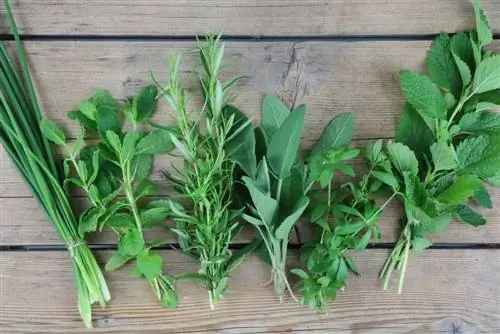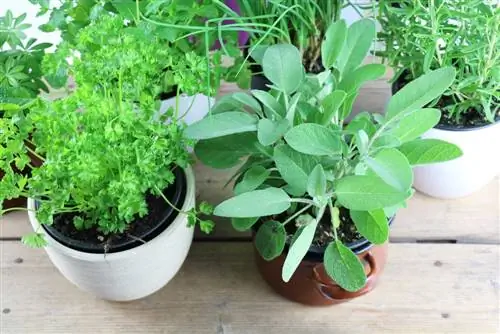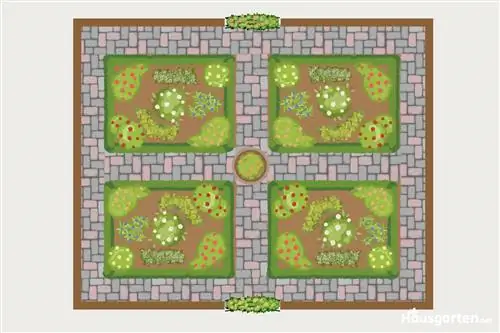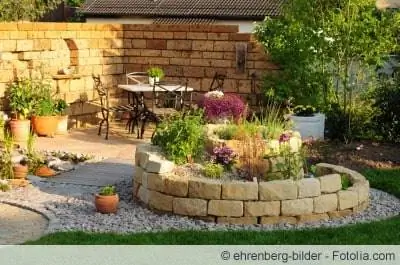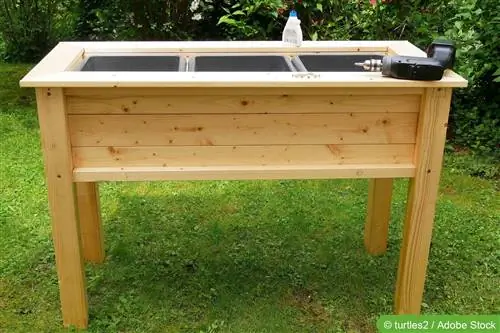- Author admin [email protected].
- Public 2023-12-17 03:39.
- Last modified 2025-01-24 12:45.
German cuisine is also discovering more and more herbs. No wonder: they are not only extremely tasty, but also he althy. Above all, they add a certain kick to many dishes. Many herbs can be easily grown in the garden in a self-made bed. And at the same time, a modern design provides new and attractive visual accents.
Location
If you're thinking about creating or building your own bed for herbs in your garden, you obviously can't avoid one question: Where should it go? The answer to this question, however, depends on which herbs exactly are to be grown. The location conditions for the plants simply have to be right - and they can be very different under certain circumstances. Of course, the space required is also important. Although this is generally limited in herb beds, it increases with the number of herb species that are to be grown. Basically, a location near the kitchen or near a garden path is always recommended. This makes it much easier to quickly get fresh herbs for cooking.
Classic
A bed for herbs can of course be created just like any other bed. The classic is the rectangular shape with a width of around 1.20 meters. There are usually several beds next to each other, separated only by narrow paths. In principle, this system also works with herbs. However, hardly anyone will plant an entire bed with just parsley or a single type of herb, as only relatively small quantities are usually required. It is therefore advisable to break up the classic version a bit and generously stock the herb bed with several different plants. The best way to do this is to think about a system for distributing the plants. For example, the following are conceivable:
- Division into planting strips
- Division into grid squares
- a circular division
- a wild mess
The latter may be particularly attractive visually, but it can make harvesting a certain type of herb quite difficult. Dividing the bed into individual squares is at least as attractive. Exactly one type of herb is then planted in each square. This makes searching and, above all, removal much easier.
Tip:
The bed also benefits from a square division if the spaces or boundaries are lined with stones or wooden elements. Small natural stones such as granite or pebbles are particularly recommended here.
Wild Bed

Many of our gardens today appear incredibly tidy and almost clinically clean. But that has little to do with nature. This often sterile impression can be counteracted with free herb beds without chaos having to take hold in the garden. Two factors benefit you: on the one hand, herb beds only require a small amount of space, and on the other hand, herb plants are generally pretty to look at and have a natural beauty. So why not create a small, wild bed of herbs in the otherwise well-kept lawn!? A circle diameter or an edge length of one meter is often sufficient. It is also conceivable to remove a paving slab from a garden path and plant the free space with herbs. Both may sound unusual and modern, but they have a great relaxing effect.
Tip:
With a distance of ten to 15 centimeters between the lawn and the bed, there are no problems when mowing the lawn. A demarcation with stones or narrow wooden planks is also conceivable.
Herb Hill
One of the ideas for a herb bed that definitely makes an impression is undoubtedly the herb hill. The name says it all. Simply pile soil into a small hill at a suitable location in the garden. Sand can also be used as a base, but it is better to work with garden soil throughout. It is important to provide the base of the hill with drainage made of pebbles and to additionally fortify it with stones. This prevents slipping. The entire hill is then simply planted all around with various herbs. In this way, with very little effort, you can bring a piece of wild nature into your garden, which quickly becomes an eye-catcher.
Herbal spiral
A bit of the hill idea is also in the herb spiral. This bed is basically oriented upwards. Delimited by natural stones, the relatively narrow planting area spirals upwards. From an aesthetic point of view, this slightly different bed shape is without a doubt a hit. Building them takes some time, but is definitely worth it. In contrast to the herb hill, the planting area itself is not slanted, but rather straight. When building, it should be ensured that the stones used are as tight as possible and cannot slip. This could damage the herbs growing underneath them. The stones should therefore definitely be tapped into place and laid straight. By the way, such a spiral can also be created at ground level.
Raised bed

For many herbs, only individual leaves are often harvested. For example, while with radishes the entire plant is pulled out of the ground, with herbs often only individual elements have to be cut off. This may take some time. So it makes sense not to have to bend down too low. A raised bed is therefore ideal for growing herbs. It doesn't even have to be very big. An area of one square meter is usually completely sufficient. A height between 90 and 110 centimeters has proven to be ideal for most people. This is how you proceed with building:
- Screwing together the bed box made of wooden boards and square timbers
- Leave openings at the top and bottom free
- Provide wood with a weatherproof glaze
- Move the box to the location
- fill in layers
Filling begins with a first layer of around 20 centimeters of coarse tree, shrub or hedge cuttings. This is followed by a layer of bark mulch, also around 20 centimeters thick, on which a similarly thick layer of leaves or grass clippings is placed. This is followed by 15 to 20 centimeters of semi-ripe compost or horse manure. Finally, another 20 centimeter thick layer of humus and garden soil is applied.
Portable bed
The big advantage of growing herbs is, among other things, that it requires a relatively large amount of space. Growing herbs seems quite modern if it is done in an old fruit crate or a discarded chest, for example. In this way you get a portable bed that can be placed in different locations in the garden, on the terrace or on the balcony. This can be extremely useful, especially in extreme weather conditions. In addition, you can always set new accents in the garden. The box or chest can of course be designed to your heart's content. There should be no shortage of ideas. The only important thing is that there are smaller holes at the bottom to avoid moisture build-up. If necessary, these must first be drilled.

